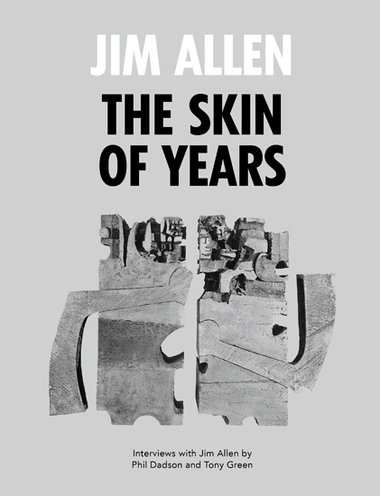John Hurrell – 10 February, 2015
Much of it is about the development of Allen's ideas concerning sculpture, installation and performance, and art education in Australia and New Zealand, but there is a lot of unanticipated material, whether that be impressively vivid descriptions of his war years as part of a 25 pound gun crew (then a machine gunner, then a flame thrower operator on a converted Bren gun carrier) in Italy, or sailing across the Tasman Sea from Sydney to Auckland singlehandedly in the mid seventies.
Auckland
Jim Allen
The Skin of Years: Interviews with Jim Allen by Phil Dadson and Tony Green
Forewords by Wystan Curnow and Blair French
340 pp, coloured and b/w illustrations
Softcover
Clouds and Michael Lett, 2014
This set of interviews with the pioneering teacher and artist Jim Allen seems designed to sit alongside the two very handy Art New Zealand interviews he has already done with Robert Leonard and Wystan Curnow (ANZ #95) and David Cross (ANZ #138), though with the former there is a little overlap. Now in his mid nineties, and still with extraordinary powers of recall - mixing astute historical observation with benign wisdom - Allen is considered by some to be this country’s first genuinely ‘contemporary’ artist. It seems logical to have old friends (like-minded, articulate writers and artists like Tony Green and Phil Dadson) to coax him along in his loquacious reminiscing. These aren’t however dialogues or balanced conversations rich in banter that to-and-fro: rather in essence they are mostly extremely informative, highly detailed, monologues. The publication is clearly about Allen. He dominates. And this - up to a point - makes a lot of sense.
Much of it - as you’d expect - is about the development of Allen’s ideas concerning sculpture, installation and performance (in general and his own practice), and art education in Australia and New Zealand, but there is a lot of unanticipated material, whether that be impressively vivid descriptions of his war years as part of a 25 pound gun crew (then a machine gunner, then a flame thrower operator on a converted Bren gun carrier) in Italy, or sailing across the Tasman Sea from Sydney to Auckland singlehandedly in the mid seventies (one of several trips, usually with one or two co-sailors). Packed with b/w and coloured images (Allen’s own or from family or friends) the thirteen chapters - rich in unnervingly precise detail - explore Allen’s teaching, art practice, friendships, travel and sailing, covering an extraordinary range of interests: historical and recreational topics tightly meshed together.
There is also a chapter where Allen by himself is discussing more recent work, a sort of extended ‘artist’s statement’ where he describes various projects and connecting threads. This would have been improved if he had a boisterous interlocutor at hand to challenge certain points (like the assumed value of reperforming old works) - not say a friend who would always blindly accept the artist’s word but somebody stroppy who would question Allen’s motives and possible insecurities about art history. The editing and proofreading in this book is disappointing too, with at least three quite famous overseas artists and writers having their names misspelt. Nevertheless - make no mistake - this is a great book overall for dipping into, especially if you want a vivid sense of the innovative ethos of the seventies and early eighties in art education and practice.
One of the helpful aspects of the book’s design, with the different chapters, is that each has not only extended footnotes at its end (written in paragraphs accompanied by photos) but also a sequential list of explored subjects at the start below each heading. This useful design element traces the meandering, overlapping aspect of these conversations to help you refind tasty snippets that you might remember- but are not sure where. It is needed because the index is not that exhaustive.
Not only is this publication rich in information about the beginnings of performance and installation art in Australasia, and Allen’s key role, but it gives you a nice sense of those qualities that are obvious when you meet the man face to face: his warmth, erudition, alertness and astute curiosity. This book exists so that the details of his aspirations, observations and developments in thought go on art historical record - an understandable publishing event in view of his considerable age - but it is perhaps too controlled and too reverential. It needs a little peppery dissent and oppositional expression so it goes clearly beyond a marketing project geared to attract institutional interest in his art production.
John Hurrell
Recent Comments
John Hurrell
EyeContact is thrilled to hear that this evening at a special event at AAG, Jim Allen was declared by the ...

 Advertising in this column
Advertising in this column Two Rooms presents a program of residencies and projects
Two Rooms presents a program of residencies and projects



This Discussion has 1 comment.
Comment
John Hurrell, 11:44 p.m. 15 September, 2015 #
EyeContact is thrilled to hear that this evening at a special event at AAG, Jim Allen was declared by the Arts Foundation of New Zealand to be an Icon for his contribution to art and art education. I'm sure all our readers will be delighted at this recognition.
Participate
Register to Participate.
Sign in
Sign in to an existing account.